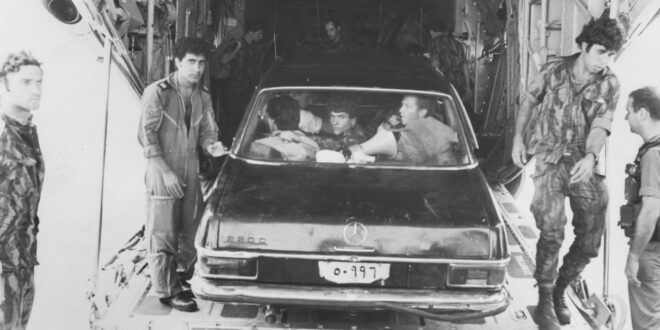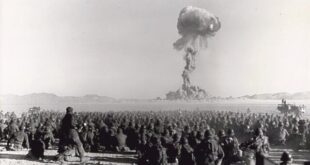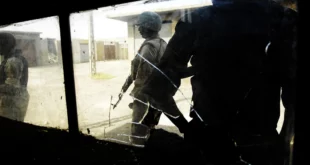by Elon Perry
The Israeli commandos wrote their farewell letters to be delivered only in the event they were killed on the high-stakes operation. Then they boarded their flights to Uganda, for a rescue raid that stunned the world.
Sunday morning, 27 June 1976. An Air France A300 airliner, Flight 139, takes off from Tel Aviv Airport to Paris, with a planned stopover in Athens. On board are 240 passengers, including the 12 crew members. Among the passengers there are 104 Israeli nationals. In Athens, 41 passengers get off the plane, and 55 new passengers come on board for the continuing flight to Paris. Among them, there were four unwelcome ones who were equipped with guns and grenades. They were two Germans, Wilfried Böse and Brigitte Kuhlmann, and two Palestinians, Jaeil al-Arja, and Abdel Latif, members of the PFLP, the Popular Front for the Liberation of Palestine.
Eight minutes after take-off, the hijacking of Flight 139 had commenced. The German terrorist Wilfried Böse got up from his seat and entered the first-class cabin, making his way to the cockpit.
The other terrorists got up and started shouting, “This is a hijacking. No one move!” while threatening the passengers from the rear and controlling the two aisles. Kuhlmann, the German woman hijacker, advanced towards the front of the plane, waving a pistol in one hand and a grenade in the other, and shouting at the passengers to stay in their seats and not to attempt to move. Böse was by then already loudly banging on the cockpit door with his gun, demanding that the pilots open it.
The captain, Michel Bacos, asked the plane’s engineer seated behind him to check what the noise was about. As soon as the door was opened, Böse forced his way into the cockpit and hit the shocked engineer with the butt of his gun and dropped him to the floor.
Böse commanded the captain and his co-pilot to remain seated behind their steering control columns. Once he felt he was in complete charge of the plane, Böse grabbed the captain’s radio microphone and contacted the Athens air traffic control tower to report the hijacking of Flight 139 and his intention to change the plane’s route to a destination in Africa.
SEE Elon Perry’s book, Children in War: A First-Hand Account of the Israeli-Palestinian Conflict
After a short stop in Benghazi for refueling, the plane was ordered to Entebbe in Uganda.
After leading their hostages into the neglected and dirty old terminal building, the hijackers instructed them to sit on the floor. The terrified passengers sat quietly staring around the terminal area, which was buzzing with large and annoying flies.
All seven terrorists gathered in the corner of the arrivals area for a briefing, while armed Ugandan soldiers pointed their weapons at the hostages. The following day, they received a visit from Uganda’s ruler, Idi Amin, who agreed to cooperate with the terrorists for 5 million dollars.
Tension in the Israeli Cabinet
The atmosphere in the Israeli Cabinet meeting was unbearably tense. Some of the ministers suggested rejecting the hijackers’ demands outright. Others thought it was better to release terrorists with blood on their hands than to abandon more than 100 helpless Israeli citizens to bleed on enemy soil more than 3,500 kms away from home. Defence Minister Shimon Peres was the only one to strongly push for a military operation to rescue the hostages. Prime Minister Yitzhak Rabin was not happy to consider a military operation – even one conducted by the Israeli commando unit which he considered to be the best in the world.
As the ministers continued to verbally wrestle with each other, struggling to find a consensus that all would be comfortable with, one of the Prime Minister’s assistants entered the room with a note in her hand. The room silenced.
All the Cabinet members were watching their Prime Minister with eager anticipation as Rabin slowly read out: “The hijackers have separated the Israeli passengers from the non-Israeli passengers.”
Some Cabinet members were Holocaust survivors. This separation conveyed them back to the Nazi extermination camps.
Entebbe: The Terrorists Single Out the Israeli Hostages
Inside the stifling terminal in Entebbe, the separation was even more painful for the hostages as they were listening to names being read out in the distinctive German accents of Wilfried Böse and Brigitte Kuhlmann.
Israel: The Plan Takes Shape
Within minutes of the jarring news of the separation, preparations for the hostage rescue operation by the Israeli military began to roll. The suggestion was to fly a large combined commando force of 200 of the best IDF fighters on four large Hercules planes, carrying numerous items of combat equipment.
The commando force would be using a black Mercedes sedan to deceive the Ugandan guards into thinking this was a surprise visit of President Idi Amin in his presidential car. After the first Hercules plane landed at Entebbe airport, the commando fighters would disembark the planes and make their way towards the terminal. The fighters, divided into four squads under the command of Yonatan Netanyahu, would storm the building in a surprise attack, eliminating the terrorists and releasing the hostages.
Landing at Entebbe
Saturday, 3 July, 11.00 p.m. The first Hercules plane, carrying Netanyahu’s commando force had landed successfully at Entebbe at exactly the estimated time of 23.00 hours. Headed by Yoni Netanyahu and his deputy Muki Betzer, nine of them climbed into the black Mercedes. The remaining 18 combatants sat waiting in two Land Rovers. Everything was ready for their disembarkation of the aircraft. In addition to the black Mercedes deception, all fighters wore leopard print army fatigues, just like those worn by Ugandan soldiers, in order to strengthen the surprise factor.
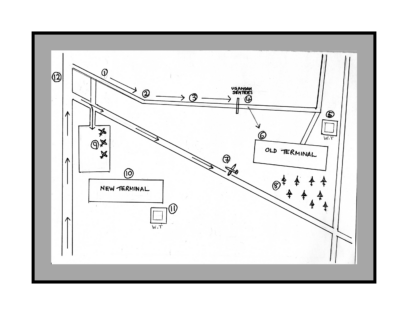
Map of the airport.
In order to avoid any dangerous confusion that could cause the Israeli commando fighters to accidentally shoot at each other, the Israeli soldiers wore white cotton hats to make it much easier for the fighters to identify their colleagues. A helmet is mandatory in battles; however, when it comes to the best trained commando fighters in the world, wearing a protective helmet is something marginal and not considered crucial.
Following the first aircraft, the rest of the planes began to land at Entebbe, leaving a space of seven minutes between each, dropping off the rest of the forces.
An Unforeseen Development
On the way to the terminal, Yoni and his deputy Muki Betzer found themselves faced with an unforeseen situation, one that caused a momentary disagreement between them, but a disagreement that over the years was to become a nationally debated issue that still resonates to this day.
When the Mercedes carrying the nine soldiers was just 300 metres from the old terminal, they encountered a checkpoint, which was actually the security gate for the terminal. Standing by the checkpoint, on either side of the road, were two armed Ugandan sentries.
Yoni became concerned, and prepared his gun to shoot them. Muki Betzer tried to dissuade him from this, explaining that it was a custom among Ugandan army soldiers to welcome you with their rifles raised, and reminded Yoni that he had already explained this fact during the training process and planning of the operation.
“Don’t worry,” said Betzer to Yoni, “they are not threatening us. It’s a custom of the Ugandan Army guards to let you know that you can proceed and that you are secured by their rifle pointed at you. I learned this when I served in Uganda a few years ago and trained their army.”
But Netanyahu thought otherwise. He still believed it would be unwise to leave an armed man with a weapon he would use.
Yoni had to make a split-second decision. He was aware of the devastating consequences of the noise of a gun if the sentry were to shoot back, something that may well remove any element of surprise.
“Yoni, please listen to me,” implored his deputy Betzer. “Let them continue to think that we are Ugandan soldiers accompanying Idi Amin in his presidential car.” But Yoni refused to listen. He instructed Giora Zussman, who was sitting directly behind him, to shoot the sentry with a pistol, which had a silencer attached.
Zussman shot the sentry, who fell to the ground but did not die instantly. Although mortally wounded, the Ugandan sentry managed to fire at the Mercedes until Yoni shot him from close range and killed him.
At that moment, everyone among the force realised they had now lost the element of surprise. However, the distance to the terminal was not great, and there was no firing coming from the watchtower yet. Yoni decided to continue as planned but the pace would be speeded up. The unwritten rule is simple: if you lose the element of surprise, you must continue the action as fast as you can, even if you have to make changes to your original plan.
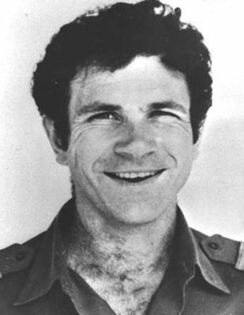
Yoni Netanyahu
Yoni instructed Amitzur, the Mercedes driver, to press his foot down hard on the accelerator and drive at maximum speed. The two Land Rovers following the Mercedes immediately began to speed up towards the terminal.
As they neared the terminal, a round of firing was suddenly heard. It was the Ugandan soldier in the watchtower, who probably by now had been woken from his sleep. Yoni and his team felt like sitting ducks. They couldn’t take shelter and stop their onslaught because they had to advance rapidly towards the terminal. The powerful firing towards them from the tower continued, but that did not stop the Israeli fighters from continuing their mission.
Mofaz’s force, whose task was to eliminate the watchtower, started intensively shooting towards it, giving Yoni and his team some cover for their final push towards the terminal.
The Hijackers Awaken
Meanwhile, inside the terminal, everyone, hijackers and hostages, began to wake up. One of the terrorists peered outside to see what was happening and who was shooting. Seeing the shooters dressed in animal print uniforms just like the Ugandan army, he ordered the hostages to lie on the floor so they would not get hurt. He told his colleague Brigitte Kuhlmann that the drama outside was a conflict amongst a group of Ugandan soldiers who had started shooting at each other, something that was not an unusual occurrence in Uganda. He and the other terrorists did not even entertain the possibility that it was the beginning of a daring operation carried out by Israeli soldiers who had flown 3,000 kilometres to rescue the kidnapped passengers.
The Rescuers Enter the Square
Yoni ordered the Mercedes driver to enter the square in front of the tower next to the terminal, thinking it would be a secure place from which he could successfully monitor and manage the attack. Upon arrival, Yoni shouted to all the fighters to get out of the vehicles and start running as fast as possible towards the terminal, each fighter to take his designated place according to the plan.
The first to leave their vehicles were the nine fighters in the Mercedes, headed by Netanyahu and Betzer, followed by the other fighters from the two Land Rovers. Everyone was starting their dash towards the glass main door of the terminal while Yoni was instructing them by using hand signals exactly according to the plan.
Upon Yoni’s hand going up, his team began to split into two squads. One ran to the right-hand corner of the terminal building, while the squad headed by deputy commander Muki Betzer began to move toward the main entrance.
Suddenly, a Ugandan soldier standing behind a small window near the terminal’s glass entrance opened fire on the Israeli fighters. Muki Betzer aimed his rifle at the window and fired an accurate round that paralysed the Ugandan soldier. Meanwhile Yoni kept on running, still shouting to his fighters to charge forward towards the terminal.
The shots raining down from the watchtower were intensifying. The Ugandan sentry stationed up in the watchtower began firing directly at Yoni, who continued to conduct the battle from outside the terminal, now completely exposed to the gunfire from the watchtower. In fact, he was the only one of his team left outside the terminal as fighters had already reached the building.
Yoni thought that the watchtower had already been neutralised by Mofaz and his team, but it turned out that when Mofaz’s team had got up to the tower, they found two sentries, one asleep and the other on guard. While Mofaz neutralised the guard on duty, the other awoke, grabbed his gun and immediately began firing towards the Israelis on the ground.
Yoni fell to the ground grimacing in pain. The intensity of the gunfire was massive and powerful. Shooting was coming from all directions. Some of the fighters fired up at the watchtower and eliminated the Ugandan soldier who had shot their commander, while other fighters sprayed the terminal’s glass wall with their gunfire.
“Yoni’s Been Hit!”
Someone shouted, “Yoni’s been hit!” and called out for someone to help him, but the fighters ignored his calls and continued with their mission. They were in fact following the instructions Yoni had given them during their training for the mission not to treat the wounded until all the hostages were freed. Each of the fighters were now acting on this instruction.
Despite the emotional difficulty of ignoring a call for help for a wounded colleague, every fighter was aware how critical every second was going to be in this short and intense battle. They knew that within seconds the terrorists could realise what was going on, and spray the hostages with bullets. It would be easy to inflict maximum damage as the hostages were huddled together on mattresses on the terminal floor.
Seconds Away
Outside, despite the thick smoke, the deafening noise all around them and the inferno of shooting from the Ugandan soldiers around the terminal and from the watchtower, the Israeli commandos were just a few short seconds away from the terminal entrance. One of the terrorists, who was not far from the terminal’s glass door, saw the commandos getting closer. He began firing wildly with his Kalashnikov rifle through the glass at the Israeli fighters. Amir Ofer, one of the Israeli commando team, was able to identify the shooter and quickly eliminated him by spraying the glass wall with massive fire. Immediately afterwards, Amir Ofer burst through the front door and slid into the large hall where the hostages were held, meanwhile shooting accurately at the stunned terrorists.
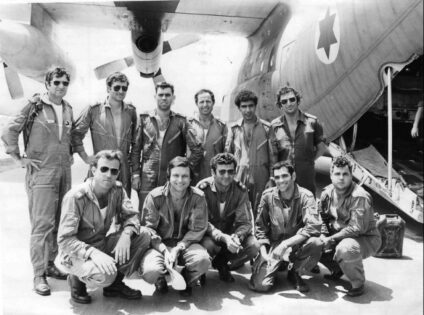
Pilots and navigators who took part in the operation.
Ofer, who had been the last out of the Land Rover after the order had been given to run, was in fact the first one to reach the terminal area. He had somehow managed to overtake everyone else and in no time stood about 10 metres from the main glass door. According to the training, Ofer was not supposed to be there before his commanders Amnon Goren and Lt Colonel Betzer. But he took the initiative and acted, not realising that he was the first to get into the terminal.
After Amir Ofer’s successful entry into the terminal, his commander Amnon Goren immediately recognised two of the terrorists, a man and a woman, who were hiding behind two chairs both aiming their Kalashnikov rifles directly at Ofer.
Amnon did not hesitate, he acted faster than they, and managed to eliminate them with accurate shots. He approached them and kicked away their weapons so that if they were not dead, they would no longer be able to use them, either on the soldiers or the hostages.
“We Are Israeli Soldiers! We Are Here to Take You Home!”
A few seconds later, Muki Betzer ran in through the same doorway. Betzer had immediately taken over command of the operation after Yoni Netanyahu was hit. As Amir Ofer and his squad commander Goren Amnon were moving towards the middle of the hall to continue to eliminate the terrorists, another of the terrorists darted behind a wide pillar at the side of the terminal, and raised his weapon. He pointed it at Muki Betzer who was standing at the entrance of the noisy and blood-spattered hall. The unskilled terrorist failed to shoot first. Betzer preceded him and shot him accurately in his chest.
Amos Goren immediately began scanning the terminal rooms to see if there were any more terrorists or Ugandan soldiers. Then he came upon the large and brightly lit room where all the hostages were held.
As more soldiers ran into the room, the hostages heard these words being shouted in Hebrew and English: “Stay down! Stay down! We are Israeli soldiers! We are here to take you home!”
The hostages lay completely still on the floor, except for a teenager named Jean-Jacques Maimoni. On seeing his Israeli saviours, Jean-Jacques jumped up in excitement, sealing his fate to die from the bullets of those who had come to rescue him. The Israeli fighters mistakenly thought he was one of the terrorists, possibly because of his young age and dark coloured hair.
A Terrorist Takes Aim
Suddenly, in the far corner of that room, Amos Goren spotted a terrorist armed with a Kalashnikov starting to get up, just behind a group of hostages who were still lying on the floor with their faces down. Amos had to be careful in his response, as the interceding hostages could get hurt.
Now the Israeli combatant needed to demonstrate the highest professional expertise of a commando fighter. In such a situation, his skills are put to an extreme test. He must show his ability to be accurate in a split second and through the use of cool judgement.
While the terrorist was pointing his weapon at him, Goren took him out with three accurately aimed shots.
At the same time, the rest of the fighters from the unit were running into the terminal building and purging the hall with continuous and accurate gunfire, which managed to eliminate all the three remaining terrorists.
Then they proceeded to the upper floor where they encountered armed Ugandan soldiers. Some of the Ugandans were able to get away, some were trapped and immobilised by the Israeli fighters, and some of them were killed in the exchange of fire.
The onslaught on the terminal lasted only one minute and 40 seconds. During this time, all the terrorists, who were the immediate threat to the lives of the hostages, along with 20 Ugandan soldiers, were killed by the Israeli commandos. Amazingly, none of the Israeli commandos who fought inside the terminal was killed by the armed terrorists, as the only fatality, Yoni Netanyahu, had been killed outside.
The mission was now completed. The Israeli forces quickly surrounded the airport and began to clear the entire area. Only when the area was deemed safe and effectively cleared of the enemy, did the evacuation of the passengers begin.
Evacuation
Sadly, as well as young Jean-Jacques Maimoni, during the exchange of fire between the terrorists and the Israeli commandos two more hostages had been killed. Fifty-six-year-old Ida Borovitch, who had been lying near an inner door, was shot in cold blood by one of the terrorists when he realised that the shooting outside was not a dispute between Ugandan soldiers. The third was 52-year-old Pasco Cohen, accidentally shot by Israeli fighters when he also stood up during the exchange of fire and started running around with joy shouting, “Israel has come to rescue us!” The Israeli troops mistook him for one of the terrorists, and shot him dead.
Also not returning to Israel would be the elderly Mrs Dora Bloch, who had been evacuated to a local Ugandan hospital just a few days before the rescue operation, and who the following day would be seized from her hospital bed and murdered on the orders of the irate and frustrated Idi Amin.
In addition, Sorin Hershko, one of the Israeli soldiers, was critically wounded. He was shot from close range by an armed Ugandan security guard wearing civilian clothes who shot Hershko directly in his neck and chest. The bullet that penetrated Hershko’s neck lodged in his spine, causing him severe damage. It left him paralysed, and he has spent the rest of his life in a wheelchair.
A Strange Silence
Immediately after all the terrorists had been eliminated by the Israeli commandos, and most of the hostages had been safely evacuated, there was a strange silence throughout the terminal. Only the bodies of the dead terrorists bleeding on the terminal floor were evidence of what had happened during the last few minutes. It felt like the soldiers were in a Hollywood movie, a dream, something not real.
It had been hard to imagine such an unfeasible operation taking place, and now being able to comprehend what was happening was almost impossible.
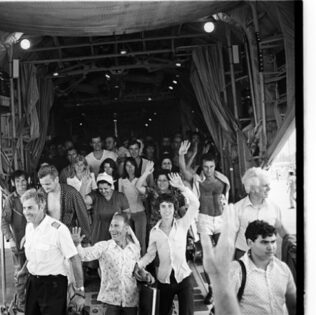
Hostages after being rescued.
“What just happened here will go into the history books,” one of the hostages said to his wife while walking towards the waiting aircraft.
“I reckon this will even reach the movie screens,” replied his wife, shaking her head.
 Soldier of Fortune Magazine The Journal of Professional Adventurers
Soldier of Fortune Magazine The Journal of Professional Adventurers


